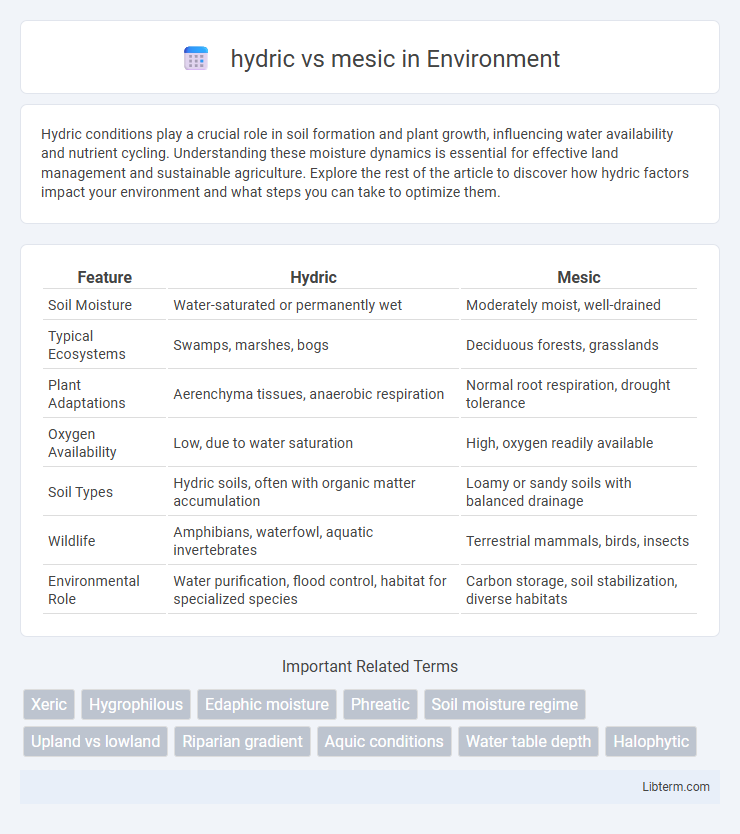Hydric conditions play a crucial role in soil formation and plant growth, influencing water availability and nutrient cycling. Understanding these moisture dynamics is essential for effective land management and sustainable agriculture. Explore the rest of the article to discover how hydric factors impact your environment and what steps you can take to optimize them.
Table of Comparison
| Feature | Hydric | Mesic |
|---|---|---|
| Soil Moisture | Water-saturated or permanently wet | Moderately moist, well-drained |
| Typical Ecosystems | Swamps, marshes, bogs | Deciduous forests, grasslands |
| Plant Adaptations | Aerenchyma tissues, anaerobic respiration | Normal root respiration, drought tolerance |
| Oxygen Availability | Low, due to water saturation | High, oxygen readily available |
| Soil Types | Hydric soils, often with organic matter accumulation | Loamy or sandy soils with balanced drainage |
| Wildlife | Amphibians, waterfowl, aquatic invertebrates | Terrestrial mammals, birds, insects |
| Environmental Role | Water purification, flood control, habitat for specialized species | Carbon storage, soil stabilization, diverse habitats |
Understanding Hydric and Mesic Environments
Hydric environments are characterized by saturated soils and frequent water presence, supporting wetland vegetation adapted to anaerobic conditions. Mesic environments feature moderate moisture levels with well-drained soils, fostering diverse plant communities that thrive under balanced water availability. Understanding the distinctions between hydric and mesic habitats is crucial for ecological restoration, wetland conservation, and land management practices.
Defining Hydric: Key Characteristics
Hydric soils are defined by their saturation with water long enough during the growing season to develop anaerobic conditions, promoting unique biological and chemical processes such as organic matter accumulation and reduced iron mobilization. These soils frequently support wetland vegetation adapted to low oxygen environments, including sedges, rushes, and various aquatic plants. The presence of hydric soils is a critical criterion for wetland identification under environmental regulations and conservation efforts.
What Makes an Area Mesic?
A mesic area is characterized by moderate moisture levels that support diverse plant and animal life without the extremes of dryness or saturation found in xeric or hydric environments. Soil in mesic habitats typically retains enough water to sustain growth but drains efficiently to prevent waterlogging, fostering balanced microbial activity and root respiration. These conditions often result from consistent precipitation, well-drained soil types, and moderate temperatures that collectively maintain equilibrium in the local ecosystem's hydrology.
Hydric vs Mesic: Main Differences
Hydric soils are saturated with water for prolonged periods, leading to anaerobic conditions that support wetland vegetation, while mesic soils have moderate moisture levels suitable for a wide range of terrestrial plants. Hydric environments typically experience frequent flooding and poor drainage, resulting in unique soil chemistry and biology distinct from the well-drained, nutrient-balanced conditions found in mesic habitats. The main differences lie in water saturation, soil oxygen availability, and plant community adaptations to these moisture regimes.
Soil Properties in Hydric and Mesic Sites
Hydric soils are characterized by prolonged saturation or flooding, leading to anaerobic conditions that result in reduced iron and manganese compounds and the formation of gleyed, mottled colors. Mesic soils, in contrast, exhibit well-drained conditions with moderate moisture availability supporting aerobic microbial activity and typical soil horizons development. Organic matter accumulates differently, with hydric soils often having higher organic content due to slower decomposition under anaerobic conditions compared to mesic soils.
Vegetation Adaptations in Hydric and Mesic Habitats
Vegetation in hydric habitats exhibits adaptations such as aerenchyma tissues and shallow root systems to survive in water-saturated soils with low oxygen availability. In contrast, mesic habitat plants develop deeper root systems and drought-resistant features to thrive in moderately moist environments with better aeration. These adaptations reflect the differing soil moisture and oxygen conditions influencing plant physiology and growth strategies.
Ecological Importance of Hydric and Mesic Zones
Hydric zones, characterized by saturated soils and unique wetland vegetation, play a crucial role in water filtration, flood control, and providing habitat for diverse aquatic species. Mesic zones, with moderate moisture levels and balanced soil conditions, support a wide range of terrestrial plants and animals, enhancing biodiversity and ecosystem stability. Both hydric and mesic zones contribute significantly to carbon sequestration and nutrient cycling, maintaining overall ecological health.
Hydric and Mesic Landscapes: Examples and Distribution
Hydric landscapes are characterized by saturated soils with frequent or permanent water presence, commonly found in wetlands, marshes, and swamps, supporting hydrophytic vegetation adapted to anaerobic conditions. Mesic landscapes exhibit moderate moisture levels with well-drained soils, typical of deciduous forests, grasslands, and temperate woodlands, supporting diverse plant species adapted to balanced hydric conditions. These distinct moisture regimes influence soil chemistry, plant community composition, and ecosystem processes, with hydric areas prevalent in coastal plains and mesic zones dominating upland terrains globally.
Human Impact on Hydric and Mesic Ecosystems
Human activities significantly alter hydric ecosystems through water diversion, pollution, and wetland drainage, leading to habitat loss and decreased biodiversity. Mesic ecosystems face impacts from agricultural expansion, urban development, and invasive species introduction, which disrupt soil moisture balance and native plant communities. Conservation efforts targeting hydric and mesic environments prioritize restoring natural hydrology and managing land use to support ecosystem resilience.
Restoring and Preserving Hydric and Mesic Areas
Restoring and preserving hydric and mesic areas requires targeted strategies that account for soil moisture regimes, with hydric soils consistently saturated or flooded, supporting unique wetland vegetation and anaerobic microbial communities critical for water filtration and carbon sequestration. Mesic environments feature moderate moisture levels supporting diverse plant species adapted to balanced soil aeration, making them essential for maintaining regional biodiversity and ecosystem resilience. Effective restoration emphasizes reestablishing natural hydrology, controlling invasive species, and promoting native flora to enhance ecological functions in both hydric wetlands and mesic terrestrial habitats.
hydric Infographic

 libterm.com
libterm.com